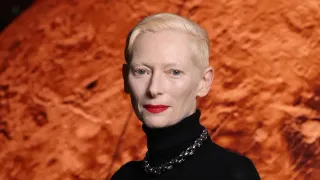
4 hours ago
Desert Queers, Divine Resistance: How a Chilean Debut Film Reclaims the AIDS Crisis Narrative
READ TIME: 5 MIN.
There's a particular kind of cruelty embedded in the mythology of the AIDS crisis—the way institutions, governments, and frightened neighbors didn't just blame gay men for a pandemic they didn't cause, but invented supernatural explanations for their hatred. In the early 1980s, as HIV began its devastating spread, queer communities faced not just biological threat but a coordinated campaign of dehumanization that suggested their very existence was contagion. Diego Céspedes' debut film, "The Mysterious Gaze of the Flamingo," takes this grotesque mythology—the notion that two men falling in love could transmit death through a glance alone—and transforms it into a sweeping, visually sumptuous meditation on queer resistance, found family, and the power of love amid catastrophe.
Set in 1982 in a remote mining town in the Chilean desert, the film follows 11-year-old Lidia as she navigates a world where an unknown, deadly disease is spreading through her community—and where queer people are being blamed for its transmission. Lidia lives not with biological parents but with a fierce, loving queer family: Flamingo, a charismatic drag performer played by Matías Catalán, and Mama Boa, a fierce matriarch portrayed by Paula Dinamarca, who leads a commune of gender-nonconforming people in a space carved out of the desert itself. As paranoia spirals and superstition overtakes reason, Lidia becomes determined to uncover the truth—not just about the disease, but about the lies being weaponized against her family.
What makes Céspedes' vision so potent is that he refuses to treat this as a historical artifact. Instead, he presents the AIDS crisis through a distinctly queer lens: one that centers trans and gender-nonconforming people, that privileges the perspectives of those most marginalized within marginalized communities, and that frames queer survival itself as a radical act of resistance. The film doesn't ask us to sympathize with queerness from the outside; it demands we live within it, breathe its air, understand its logic and beauty from the inside out.
In May 2025, "The Mysterious Gaze of the Flamingo" premiered in the Un Certain Regard section at the 78th Cannes Film Festival, where it won the section's top prize—a significant achievement for a first-time feature director and a powerful statement about the international film community's recognition of queer storytelling. The film also received nominations for the Queer Palm and the Camera d'Or, cementing its status as one of the festival's most talked-about entries.
This recognition matters deeply for LGBTQ+ cinema. For decades, queer stories—especially those centered on trans and gender-nonconforming people—have been relegated to the margins of film festivals, if they've been programmed at all. A Cannes win for a film that centers a commune of drag performers and gender-nonconforming people navigating state-sanctioned persecution sends a clear message: this is not niche cinema. This is cinema, period. The film's international co-production status—a collaboration between Chile, France, Belgium, Spain, and Germany—further underscores that queer stories transcend borders and demand global attention.
The film has continued its festival circuit momentum, earning nominations and wins at prestigious venues including the Lima Film Festival and the San Sebastián International Film Festival, where it won the Dama Youth Award in September 2025. It was also selected as the Chilean entry for Best International Feature Film at the 98th Academy Awards, a recognition that speaks to both its artistic merit and its cultural significance.
The AIDS crisis occupies a particular place in queer collective memory—it is, simultaneously, a moment of profound loss and a moment of extraordinary community organizing, care work, and resistance. For those who lived through it, it's personal. For younger queer people, it's history that shapes the world they inhabit. Cinema has grappled with this moment before, but often through frameworks that center straight sympathy or medical tragedy. Céspedes takes a different approach entirely.
By setting the narrative in the early 1980s—the moment when HIV was beginning to spread but before it was widely understood or named—the film plays with temporal ambiguity in a way that feels deliberately queer. Is the disease real? Is it a metaphor? Does the distinction matter when the violence directed at queer people is absolutely, materially real? The film refuses easy answers, instead asking viewers to sit with the discomfort of living in a world where your existence is treated as a threat, where your capacity to love is framed as lethal.
The visual language of the film—described as blending "sensuous magical realism" with "poetic tenderness" against the harsh desert backdrop—refuses the clinical, medicalized aesthetic that has often characterized AIDS cinema. Instead, Céspedes creates tableaus that honor the beauty, resilience, and joy of queer life even as it's under siege. This is cinema that understands that queer history is not only about suffering; it's about survival, community, and the defiant persistence of love.
At the heart of the film is Lidia's relationship with her queer family—Flamingo and Mama Boa and the broader community of gender-nonconforming people who have created a home in the desert. This framing is particularly significant for trans and gender-nonconforming viewers. For decades, mainstream cinema has either erased trans people from narratives about queer history or relegated them to supporting roles in stories centered on cisgender gay men. By making Mama Boa a central figure—a fierce matriarch who leads her community—the film asserts that trans women have always been at the forefront of queer resistance.
The concept of found family is not new to queer cinema, but the film's treatment of it feels urgent and contemporary. In a world where biological families have often rejected their queer members, found family has been a survival strategy, a political necessity, and a source of profound love. By centering this dynamic in a historical narrative about the AIDS crisis, Céspedes suggests that the care structures queer people built to survive the pandemic were extensions of care structures that had always existed—the chosen families that have sustained queer life for generations.
"The Mysterious Gaze of the Flamingo" is scheduled for theatrical release in Spain on January 16, 2026, with a planned release in Chile in the first half of 2026. The film has already screened at major North American festivals, including the Toronto International Film Festival and the Chicago International Film Festival, where director Diego Céspedes was scheduled to attend.
For LGBTQ+ audiences, this film represents something increasingly rare in contemporary cinema: a work that centers queer joy, queer resistance, and queer beauty without needing to justify its existence to straight viewers. It's a film made by a queer filmmaker , featuring a predominantly queer cast, and telling a story that matters to queer people first and foremost. In an era when many LGBTQ+ narratives are still filtered through straight frameworks and straight sympathy, this feels genuinely revolutionary.
In 2025, as we continue to reckon with the historical erasure of queer perspectives in narratives about the AIDS crisis, "The Mysterious Gaze of the Flamingo"arrives as a necessary intervention. It's a film that says: we were here, we were beautiful, we were resilient, and our stories matter. It's a film that centers those most marginalized—trans people, gender-nonconforming people, those at the intersection of multiple oppressions—and treats their survival as heroic. It's a film that refuses the mythology of blame and instead offers something far more radical: an affirmation of queer love as resistance, as defiance, as the most powerful force against the violence of a world determined to erase us.
For LGBTQ+ audiences, this is cinema that sees us, that honors our history, and that insists on our right to tell our own stories. And in a world that continues to criminalize, pathologize, and marginalize queer people, that feels like everything.






